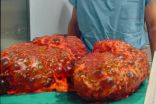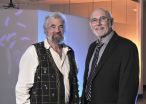American Heart Association pre-arrival telephone CPR guidelines help save lives
Implementing American Heart Association pre-arrival telephone CPR guidelines throughout Arizona has dramatically increased the number of bystanders performing CPR and survival from cardiac arrest, according to research presented at the American Heart Association's Scientific Sessions 2014.
The guidelines call for emergency dispatchers and call takers to provide assertive step-by-step Telephone-CPR instructions to bystanders during a 9-1-1 call.
Researchers analyzed and linked over 4,000 9-1-1 audio recordings in eight dispatch centers in Arizona during a three-year period with EMS and hospital outcome data. The AHA Telephone-CPR recommendations were implemented using a bundled approach of guideline -based protocols, interactive training materials, data collection and a continuous quality improvement program.
They found: A 41 percent relative increase in the rate of Telephone-CPR from 44 percent to 62 percent. The time from call receipt to starting the first chest compression with Telephone-CPR decreased from 178 to 155 seconds. A relative increase in survival of 42 percent from 7.9 percent to 11.2 percent.
Seventy percent of Americans feel helpless to act during a cardiac emergency because they don't know how to administer CPR or their training has significantly lapsed, according to American Heart Association CPR statistics.
Bentley J. Bobrow, M.D., Arizona Department of Health Services, Phoenix, Arizona; Arizona Emergency Medicine Research Center, Phoenix, Arizona
Note: Actual presentation is 10:30 a.m. CT/11:30 a.m. ET, Saturday, Nov. 15, 2014.
Abstract 13359/Presentation 5 (Lakeside Hall D1, Cross Core)
Angioplasty immediately after cardiac arrest may improve survival
People who undergo angioplasty immediately after a cardiac arrest have better short- and long-term survival rates compared to those who don't, according to research presented at the American Heart Association's Scientific Sessions 2014.
Percutaneous coronary intervention (PCI), commonly known as angioplasty, is a non-surgical procedure that helps open blocked arteries.
French researchers analyzed data from 1,722 patients (71 percent male, average age 60) who suffered a cardiac arrest away from a hospital. They found: Thirty-day, 3-year and 10-year survival rates were 42 percent, 37 percent and 32 percent in patients receiving PCI compared to 26 percent, 19 percent and 13 percent respectively, in patients who did not. PCI was associated with a 29 percent lower 30-day and 59 percent lower long-term risk of death.
Guillaume Geri, M.D., Cochin Hospital's Medical Intensive Care Unit in Paris, France
Note: Actual presentation is 1:30 p.m. CT/2:30 p.m. ET, Saturday, Nov. 15, 2014.
Abstract 16170/Presentation 179 (Lakeside Ballroom E354, Cross Core)
Women are more likely to survive sudden cardiac arrest, says international study
Women are 11 percent more likely to survive an out-of-hospital cardiac arrest compared to men, according to researchers at the American Heart Association's Scientific Sessions 2014.
Cardiac arrest is the abrupt loss of heart function in a person who may or may not have diagnosed heart disease. The time and mode of death are unexpected. It occurs instantly or shortly after symptoms appear.
Researchers reviewed data from 13 independent international studies (38 percent included U.S. registries) involving 409,323 patients. In most studies, the researchers found that more women faced unfavorable circumstances when a cardiac arrest occurred. For example, many women were older, had lower instances of having a "shockable" heart rhythm and didn't receive CPR from bystanders when compared to men.
But women were still more likely to survive to hospital discharge.
Further studies are needed to explain the paradox.
Wulfran Bouguin, M.D., Hôpital Cochin, Paris, France
Note: Actual presentation is 4:45 p.m. CT/5:45 p.m. ET, Saturday, Nov. 15, 2014.
Abstract 13832/Presentation 262 (Lakeside Ballroom E354, Cross Core)
Women less likely to be successfully resuscitated after out of hospital cardiac arrest, says Dutch study
Women are less likely to be successfully resuscitated with CPR by emergency medical services when they have a cardiac arrest outside of the hospital, according to researchers in The Netherlands who presented at the American Heart Association's Scientific Sessions 2014.
Researchers identified 22,443 out-of-hospital cardiac deaths (52.8 percent male) and reviewed data on 6,038 out-of-hospital CPR attempts by emergency medical services (72.5 percent male) in the same study region, all aged over 20. They found: Women have a significantly lower chance of receiving a resuscitation attempt from emergency medical personnel than men (15 percent women vs. 35 percent men). Women had a significantly lower chance of successful survival after a resuscitation attempt than men (13 percent women vs. 20 percent men). Women had a lower proportion of "shockable" initial heart rhythm (34 percent women vs. 49 percent men), a strong determinant of survival.
Social factors (such as older women living alone) as well as biological factors (such as women presenting with different symptoms or more heart failure as cause of the sudden cardiac arrest) may be reasons why women have less chance of receiving CPR, researchers said.
While this study took place in The Netherlands, researchers believe their findings would also be applicable in the United States.
Marieke Blom, Ph.D., The Heart Failure Research Center at the Academic Medical Center in Amsterdam, The Netherlands
Note: Actual presentation is 8 a.m. CT/9 a.m. ET, Saturday, Nov. 15, 2014.
Additional Resources: Available multimedia resources (photos/videos/graphics) are available on the right column of the release link http://newsroom.heart.org/news/resuscitation-science-tip-sheet?preview=8c1fbc6314fba060522fffb6b40bcf9f For more news from AHA's Scientific Sessions, follow us on Twitter @HeartNews #AHA14
INFORMATION:
Statements and conclusions of study authors that are presented at American Heart Association scientific meetings are solely those of the study authors and do not necessarily reflect association policy or position. The association makes no representation or warranty as to their accuracy or reliability. The association receives funding primarily from individuals; foundations and corporations (including pharmaceutical, device manufacturers and other companies) also make donations and fund specific association programs and events. The association has strict policies to prevent these relationships from influencing the science content. Revenues from pharmaceutical and device corporations are available at http://www.heart.org/corporatefunding
NOTE: ALL TIMES ARE CENTRAL. THESE TIPS ARE EMBARGOED UNTIL 8 a.m. CT/9 a.m. ET Saturday, Nov. 15, 2014. For more information Nov. 15-19, call the AHA News Media Staff Office in the McCormick Convention Place Center in Chicago at (312) 949-3400. Before or after these dates, call the Communications Office in Dallas at (214) 706-1173. For public inquiries, call (800) AHA-USA1 (242-8721).
For Media Inquiries:
AHA News Media in Dallas: (214) 706-1173
AHA News Media Office, Nov. 15-19,
at the McCormick Place Convention Center: (312) 949-3400
For Public Inquiries: (800) AHA-USA1 (242-8721)
heart.org and strokeassociation.org
Life is why we fund scientific breakthroughs that save and improve lives.

